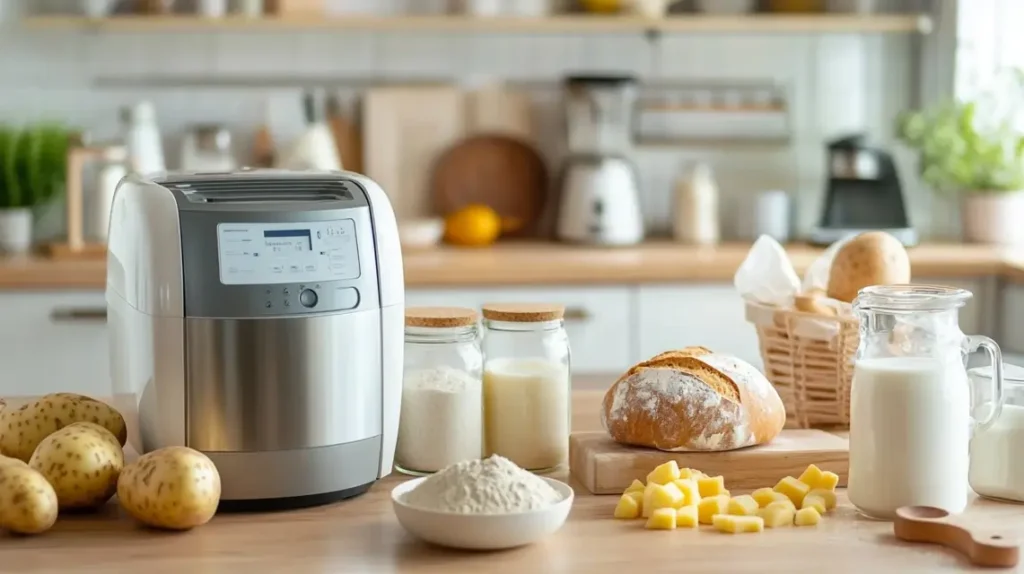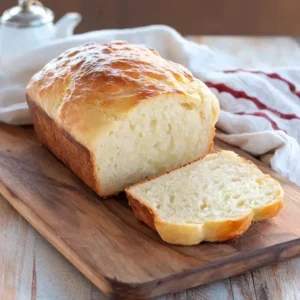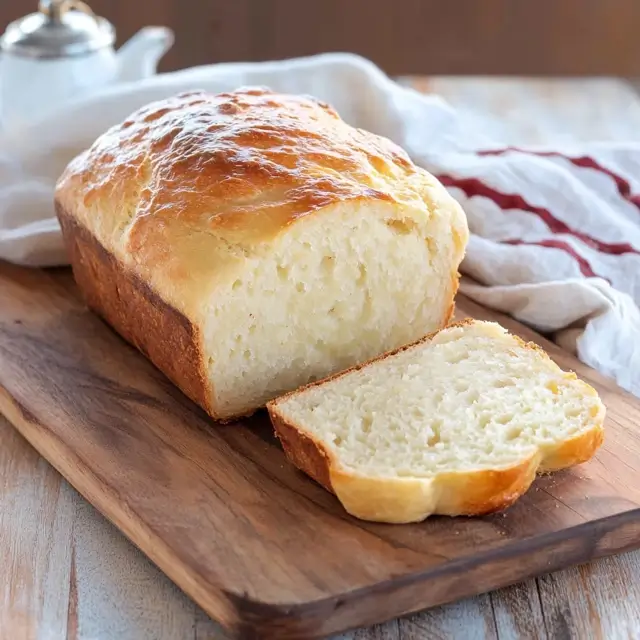If you’re looking for a super soft, tasty loaf of bread you can make with almost no effort, you’re in for a treat. This bread machine potato bread recipe is simple, fluffy, and packed with a mild flavor that makes every bite comforting.
In this guide, we’ll walk you through every step of making homemade potato bread in your bread machine. You’ll learn what ingredients you need, how to set up your machine, and tricks to make your bread turn out just right.
Whether you’re new to baking or a seasoned kitchen pro, this guide has got you covered in plain, easy-to-understand words. Let’s get started!
Why Make Potato Bread in a Bread Machine?
What Makes Potato Bread Special?

“Visual introduction to the tools and ingredients needed for this recipe.”
Potato bread isn’t just a fun twist on white bread it’s softer, holds moisture better, and lasts longer without drying out. Thanks to the potato flakes in the dough, this bread turns out fluffy on the inside with a nice golden crust.
“Potato bread has a softer, more tender crumb than traditional white bread. The starch from the potatoes holds more water, giving the bread a moist texture.”
Bread Dad
People love it because it’s super versatile. You can use it for toast, sandwiches, or even French toast. And kids? They love the mild, buttery taste.
How Potato Flakes Make Bread Soft and Tasty
Now you might be thinking, “Potato flakes? Really?”
Yep! Instant mashed potato flakes are the secret ingredient in this bread machine potato bread recipe. Here’s why:
- They’re easy to measure.
- They give your bread a moist, light texture.
- They don’t mess up the dough like real mashed potatoes sometimes can.
“Always use dry potato flakes. Moist mashed potatoes have too much water, which can make the bread collapse or turn out gummy.”
You won’t even taste the flakes just a hint of warm, comforting flavor that makes this loaf something special.
Nutrition Facts (Per Slice – Approx.)
| Nutrient | Amount |
|---|---|
| Calories | 202 kcal |
| Carbs | 32 g |
| Protein | 6 g |
| Fat | 5 g |
| Saturated Fat | 3 g |
| Sodium | 336 mg |
| Fiber | 1 g |
| Sugar | 4 g |
| Calcium | 45 mg |
| Iron | 0.4 mg |
Ingredients You’ll Need
Key Ingredients for Potato Bread Success
You don’t need anything fancy to make this bread machine potato bread recipe just a few pantry staples and about 5 minutes of prep. Let’s break it down!
“Stick with simple, fresh ingredients, and your bread machine will do all the heavy lifting.”
Home Bakers Weekly
Here’s what you’ll need:
| Ingredient | Amount (for 2 lb loaf) |
|---|---|
| Warm Milk | 1 ½ cups (345 ml) |
| Unsalted Butter (softened) | 4 tbsp (57 g) |
| Potato Flakes (Dry) | ½ cup (28 g) |
| Bread Flour | 3 ½ cups (420 g) |
| Granulated Sugar | 2 tbsp (25 g) |
| Dried Rosemary (optional) | ½ tsp (1 g) |
| Salt | 1 ½ tsp (9 g) |
| Bread Machine Yeast | 1 ½ tsp (4.5 g) |
Now, let’s clear something up: Don’t use mashed potatoes! Stick with dry instant potato flakes they help make your bread light and fluffy without throwing off the moisture balance.
Choosing the Right Type of Potato Flakes and Flour
Not all potato flakes are created equal. Go for plain instant potato flakes with no added flavors or seasonings. This keeps the taste neutral and perfect for anything from sandwiches to breakfast toast.
When it comes to flour, always use bread flour instead of all-purpose. Why? It has more gluten, which gives your bread structure and chew.
“Using all-purpose flour might leave your bread a bit flat or dense. Bread flour is the better pick for structure and softness.”
If you’re into creative substitutions, like gluten-free or vegan options, check out this vegan gluten-free bread machine recipe for inspiration.
Step-by-Step Bread Machine Potato Bread Recipe
Setting Up Your Bread Machine for Potato Bread
Once your ingredients are lined up, it’s go time! Follow these simple steps to make the perfect loaf in your bread machine.
Instructions:
- Unplug the bread machine and remove the pan.
- Add the ingredients in this order:
- Milk (warm)
- Butter
- Sugar
- Salt
- Potato flakes
- Bread flour
- Lastly, add the yeast in a small “flour crater” on top (this keeps it from touching the liquid too soon).
- Put the pan back in the machine and plug it in.
- Select these settings:
- Basic/White Bread
- Light crust color
- 2 lb loaf
- Hit Start and let the machine do its magic.
“Never let yeast and salt touch before mixing salt can kill yeast and mess up the rise.”
Most machines take about 3 hours for a full cycle, but yours might be a little different. Check the display timer to know when to come back.
Mixing and Baking – What to Expect
Once it starts, you’ll hear the machine mixing the dough. If the dough looks too dry or wet after the first few minutes, feel free to open the lid (but only during the mixing/kneading stage).
“If your dough looks like cookie batter, you’ve added too much liquid. If it’s crumbly, it needs more!”
The final result should be a smooth, golden loaf with a soft inside and light rosemary aroma if you used that option. Let it cool for at least 30 minutes before slicing.
Common Mistakes and How to Avoid Them
Don’t Use Real Mashed Potatoes – Here’s Why
This might surprise you, but real mashed potatoes don’t work well in a bread machine potato bread recipe. They have way too much moisture, and every batch is different.
“Moist mashed potatoes can throw off your whole bread texture and leave it soggy or sunken.”
Instead, always go for dry instant potato flakes. These are easy to measure and give consistent results every single time. They also mix better with the dough and help your bread rise the right way.
Here’s a quick tip: store your potato flakes in an airtight jar, especially if you live in a humid area. That way, they don’t soak up extra moisture from the air.
How to Prevent Bread from Collapsing or Sinking
No one likes a flat, sad-looking loaf, right? Well, there are a few small mistakes that can make your bread fall or collapse in the bread machine.
Let’s go over the most common ones and how to fix them:
| Problem | Why It Happens | Fix It By… |
|---|---|---|
| Bread sinks in the middle | Too much liquid or using moist potatoes | Use only dry flakes, and measure liquids carefully |
| Bread is too dense | Old yeast, cold ingredients, or wrong flour | Use fresh yeast, warm milk, and always use bread flour |
| Bread didn’t rise much | Yeast touched salt too early or expired yeast | Place salt away from yeast in the bread pan |
| Top of bread caved in | Dough too wet or machine too hot during baking | Stick to the recipe and don’t open the lid mid-bake |
“Yeast is picky! Keep it happy by using warm liquids and storing it in a cool, dry place.”
Helpful Tips for First-Time Bakers
Best Tips for Making Fluffy, Light Potato Bread
If this is your first time using a bread machine, don’t worry. Once you get the hang of it, you’ll be baking like a pro! These simple tips will help you get the best loaf every time:
- Use warm milk, not straight from the fridge. Cold milk slows the yeast and makes dense bread.
- Always add ingredients in the right order: liquids first, then dry, and yeast last.
- Don’t let the yeast touch the salt before mixing. Salt can kill yeast!
- Check your dough during the first 10 minutes of mixing. It should form a smooth ball not too sticky, not too dry.
“Think of your dough like play dough soft and stretchy is just right.”
Another important tip? Stick to the measurements. Even a little extra milk or flour can change everything.
Storage, Slicing, and Reheating Tips
Once your potato bread is done, you’ll want to store it right to keep it soft and fresh.
Here’s how to do that:
- Let it cool completely before slicing. This keeps the inside fluffy and prevents tearing.
- Store in a bread box or sealed plastic bag at room temperature for up to 3 days.
- For longer storage, freeze slices in a zip-top bag. Just toast them when you’re ready!
“Potato bread freezes really well. Just wrap it tightly and it’ll taste fresh even weeks later.”
If you’re looking for more homemade bread ideas, try checking out this sourdough garlic bread recipe over on Yuum Recipes. It’s perfect for anyone who loves baking flavorful loaves from scratch.
Fun Variations to Try
Garlic, Cheese, and Herb Potato Bread Ideas
Once you’ve mastered the basic bread machine potato bread recipe, why not try adding your own tasty twist? It’s super easy to mix in some bold flavors that turn your everyday loaf into something amazing.
Here are a few delicious ideas to get your creativity rolling:
- Garlic-Lovers’ Delight: Add 1 teaspoon of garlic powder or minced garlic with the dry ingredients.
- Cheesy Potato Bread: Toss in ½ cup of shredded cheddar or parmesan during the last kneading cycle. This adds a gooey, savory kick!
- Herb Heaven: Mix in dried herbs like thyme, oregano, or basil. They pair perfectly with the soft texture of potato bread.
“The best part about potato bread? It’s a perfect blank canvas for savory flavors!”
Just remember don’t overload the dough. Too many extras can mess with how your bread rises.
Making Rolls and Sandwich Bread from This Recipe
You can also use the bread machine potato bread recipe dough to make other shapes, not just a loaf! Yup, this dough is super flexible.
Try these fun ideas:
- Dinner Rolls: Let the machine knead and rise the dough. Then shape it into small balls, let them rise again, and bake them in the oven at 375°F for 15–20 minutes.
- Sandwich Bread: Want a more traditional sandwich shape? After the dough is ready, move it to a regular bread pan and bake in the oven for a smooth top and square edges.
“One recipe, lots of tasty possibilities. Don’t be afraid to experiment!”
If you love trying new bread shapes, you might also enjoy our guide on using just the dough cycle on a bread machine, which shows you how to bake bread your way.
Using Your Bread for More Than Sandwiches
Creative Ways to Enjoy Potato Bread

“Highlighting the versatility of potato bread in different meal settings.”
Sure, you can slice this bread for sandwiches, but that’s just the beginning. With its soft, rich texture, potato bread is super versatile.
Here are some fun and tasty ways to eat it:
- Breakfast Toast: Top with butter and honey, or go savory with avocado and egg.
- French Toast: The slightly sweet flavor makes it perfect for dipping into egg batter and frying up golden.
- Croutons: Cut into cubes, toast with olive oil and herbs, and add to soups or salads.
“Potato bread gives your meals a little something extra whether it’s morning, noon, or night.”
The soft inside and firm crust make it a solid choice for meals that need a bread that holds up but still feels light and fluffy in every bite.
Turn Potato Bread into a Toasty Panini or Breakfast Treat
This bread machine potato bread recipe isn’t just for basic toast it also makes an awesome grilled sandwich or snack!
Try these ideas:
- Panini Perfection: Add turkey, spinach, and mozzarella between two thick slices, then grill until the cheese melts.
- Egg-in-a-Hole: Cut a circle in the middle of a slice, crack in an egg, and cook it in a pan for a fun breakfast treat.
- Mini Pizza Toasts: Add marinara sauce, shredded cheese, and your favorite toppings then toast it in the oven.
“A little creativity turns simple potato bread into a snack that steals the show.”
FAQs About Bread Machine Potato Bread
Can I use real mashed potatoes instead of flakes?
This is one of the most common questions and it makes sense! But the answer is no, it’s best not to.
Real mashed potatoes hold too much water and vary from batch to batch. This can make your bread too wet and cause it to sink. That’s why the bread machine potato bread recipe uses dry instant potato flakes they’re super reliable and easy to measure.
“Stick with potato flakes and you’ll get soft, fluffy bread every time.”
What type of flour works best in this recipe?
Always use bread flour, not all-purpose. Why? Bread flour has more gluten, which helps your loaf rise higher and stay nice and chewy on the inside. It also holds shape better in a bread machine.
If you only have all-purpose flour, it’ll still work, but your loaf might be flatter or more dense.
Why didn’t my potato bread rise properly?
There are a few possible reasons:
- Your yeast might be old or expired.
- You used cold milk, which slows down yeast growth.
- The salt touched the yeast before mixing, which can kill the yeast.
To avoid this, always use fresh yeast, warm milk (not hot!), and keep salt on the opposite side of the pan from the yeast.
Can I make this recipe dairy-free?
Yes, you totally can! Just swap out the milk for warm water or a plant-based milk like almond or oat milk. Use a dairy-free butter or oil, and you’re good to go.
“Potato bread is super flexible it can still be soft and tasty without dairy.”
Final Thoughts and Next Steps
Why This Potato Bread Recipe is Worth Saving
This bread machine potato bread recipe isn’t just easy it’s a total game-changer for homemade bread lovers. It gives you that soft, fluffy texture with a slight golden crust, plus the light flavor of potato that works well with both sweet and savory toppings.
And the best part? The bread machine does most of the work!
You can mix things up with garlic, cheese, or herbs. Or even shape the dough into dinner rolls and sandwich loaves. It’s super versatile, super tasty, and perfect for anyone who wants great bread without spending hours in the kitchen.
“Once you try potato bread, it’s hard to go back to plain white bread.”
More Bread Machine Recipes to Try Next
If this recipe has you excited to bake more, you’re in luck! Potato bread is just the start.
You might want to explore more easy recipes, like:
- Soft white sandwich bread
- Cinnamon raisin bread
- Buttery milk bread
- Herb focaccia (yes, you can prep the dough in the bread machine!)
For more delicious homemade bread ideas, check out our full collection of bread recipes over at Yuum Recipes!

Bread Machine Potato Bread
Equipment
- Bread Machine
- Measuring cups and spoons
Ingredients
Main Ingredients
- 1 ½ cups warm milk
- 4 tbsp unsalted butter softened
- ½ cup dry potato flakes
- 3 ½ cups bread flour
- 2 tbsp white sugar
- ½ tsp dried rosemary optional
- 1 ½ tsp salt
- 1 ½ tsp bread machine yeast
Instructions
- Add warm milk, softened butter, and sugar to the bread machine pan.
- Sprinkle the dry potato flakes over the liquid, followed by the bread flour, ensuring the flour fully covers the liquid.
- Add salt and optional dried rosemary to the corners of the pan, keeping them separate from the yeast.
- Make a small well in the center of the flour and add the yeast.
- Select the Basic or White Bread cycle, crust preference, and press Start. Once baked, let cool before slicing.
Notes
Conclusion
So there you have it your complete guide to making the perfect loaf using this bread machine potato bread recipe. With just a few simple ingredients and the press of a button, you can have bakery-quality bread right at home.
Whether you’re baking your first loaf or your hundredth, this recipe is a winner. It’s soft, tasty, and super easy to customize.
Give it a try and see why so many people say, “This is the best bread I’ve ever made!”

